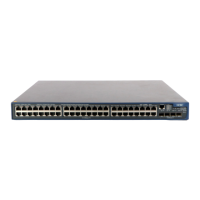1-44
By default, a switch does not operate as a secondary root bridge.
If you do not specify the instance-id argument, the two commands apply to only the CIST.
You can configure one or more secondary root bridges for an MSTI. If the switch operating as the root
bridge fails or is turned off, the secondary root bridge with the least MAC address becomes the root
bridge.
You can specify the network diameter and the hello time of the switch when you are configuring it as a
secondary root bridge. The switch will then figure out the other two time parameters: forward delay and
max age. If the instance-id argument is specified to 0 in this command, the current switch is configured
as the secondary root bridge of the CIST. You can configure only one root bridge for an MSTI but you
can configure one or more secondary root bridges for an MSTI.
Once a switch is configured as the root bridge or a secondary root bridge, its priority cannot be modified.
Examples
# Configure the current switch as a secondary root bridge of MSTI 4, setting the network diameter of the
switched network to 5 and the hello time of the current switch to 300 centiseconds.
<Sysname> system-view
System View: return to User View with Ctrl+Z.
[Sysname] stp instance 4 root secondary bridge-diameter 5 hello-time 300
stp root-protection
Syntax
stp root-protection
undo stp root-protection
View
Ethernet port view
Parameters
None
Description
Use the stp root-protection command to enable the root guard function on the current switch.
Use the undo stp root-protection command to restore the root guard function to the default state on
the current switch.
By default, the root guard function is disabled.
Because of configuration errors or malicious attacks, the valid root bridge in the network may receive
configuration BPDUs with their priorities higher than that of the root bridge, which causes new root
bridge to be elected and network topology jitter to occur. In this case, flows that should have traveled
along high-speed links are led to low-speed links, causing network congestion.
You can avoid this problem by utilizing the root guard function. Root-guard-enabled ports can only be
kept as designated ports in all MSTIs. When a port of this type receives configuration BPDUs with
higher priorities, it turns to the discarding state before it is specified as a non-designated port and stops
forwarding packets (as if it is disconnected from the link). It resumes the normal state if it does not
receive any configuration BPDUs with higher priorities for a specified period.

